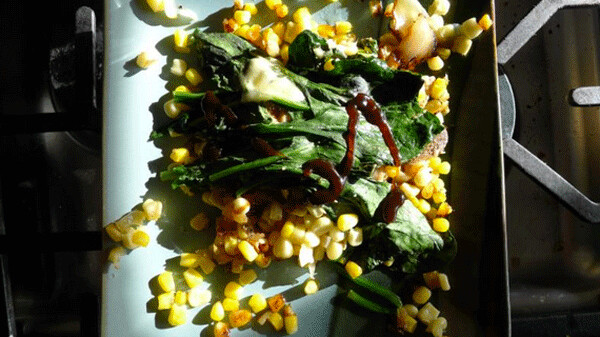Community Supported Seed Culture

When planting seeds, it pays to think about recipes you will make with the produce. Plans for pesto call for Genovese basil. A mojito enthusiast needs a big ole’ mint patch. One should have five recipes, minimum, at the ready for each zucchini plant.
My garden is currently being redesigned by a Filipino sauté of corn and spinach. It’s a colorful combination, like green trees under the summer sun, and my family crowds the pan when I make it.
My garden plan includes enough corn to eat some and still have a few quarts to freeze, so that by this time next year I’ll have frozen corn for my sauté. And I will finally plant my spinach patch, which will overwinter, so that this time next year I’ll have fresh spinach for my sauté.
As my seeds have not even arrived yet, much less planted or harvested, I still have plenty of time to mess around with my sauté using pre-grown ingredients. I have tweaked and modified the original recipe so many times that its original creator may no longer wish to be associated with it. But nonetheless, a shout-out to Liza Agbanlog and her blog Salu Salo, which means “getting together to eat” in Filipino.
I replaced her shrimp paste with anchovies, which were in turn replaced by sardines. The hoisin sauce and cheese came later.
This year’s seed order includes a variety of yellow and white corn called ‘Who Gets Kissed?’, and a spinach by the name of ‘Abundant Bloomsdale.’ Both varieties were developed via a process called Participatory Plant Breeding, in which breeders seek input from a wide variety of stakeholders. These advisors include the likes of farmers, plant disease specialists, seed companies, chefs and consumer tasters-anyone with an interest in helping improve a seed.
For as long as humans have been planting seeds, we have been seeking to customize them for our own purposes. Today the tools are sharper, but modern seed breeders still follow the basic protocols established when plants were first domesticated: namely, to save and replant seeds from favored plants. Nowadays, breeders can mix and match traits from different individuals and combine them in a seed with impressive dexterity. Participatory Plant Breeding adds a new level of input by, essentially, connecting a network of brains together to program a vegetable plant.
‘Who Gets Kissed’, named after a game once played by young cornhuskers, was developed for vigor in cool soils, resistance to certain corn diseases and high yields. It has a rich, sweet flavor, an is one of only a handful of open-pollinated sweet corn seeds on the market, according to Kiki Hubbard of the Organic Seed Alliance, a non-profit that supports the development and use of organic seeds.
“Open-pollinated” refers to seeds that grow into plants, the seeds of which can be saved and replanted-as opposed to hybrid seeds, which won’t grow up to resemble their parents and aren’t worth saving. Over time, farmers who select and save their seed may become de-facto breeders, helping their seed stock adapt to local conditions. The Organic Seed Alliance’s support for organic seed is rooted in a similar concept of adaptation: that seeds developed under organic conditions are better suited, genetically, to be grown organically.
Hubbard says that seeds bred for organic farms, which prioritize soil health and biodiversity, have different needs than seeds bred for conventional agriculture systems, and face different challenges. “Seed provides genetic tools with which a plant can meet these challenges, and breeding plants in the environment of their intended use can deliver these beneficial genetics.”
She told me about another Participatory Plant Breeding project, a cucumber strain called DMR 401 that shrugs off downy mildew, a disease that is currently terrorizing the cucumber industry in the East and Midwest.
The strain is so resistantthat non-organic growers are seeking out DMR 401 seed. “Pesticide controls are losing their effectiveness against this ever-evolving pathogen,” she said. But breeders, with the assistance of Participatory Plant Breeding projects, are proving able to breed their plants faster than the pathogen itself can evolve, and stay ahead of the disease.
As for that Abundant Bloomsdale Spinach, Hubbard’s experience is more anecdotal, but equally impressive. Bred for its dark, glossy and thick leaves and slow-to-bolt temperament, it’s also so irresistibly sweet that last year her young son pillaged the spinach patch on a daily basis.
Sautéed Spinach and Corn
This dish is extremely flexible, forgiving and accommodating. Feel free to add whatever proteins, spices or extra vegetables you can think of, and otherwise adapt the recipe to your home kitchen environment. Here I offer one variation, but if sardines, cheese and hoisin sauce aren’t favored at your household, don’t select those traits. Like seeds in the hands of a breeder, this recipe may take a few incarnations until you have it where you want it.
Serves 2
1 tablespoon olive oil
2 cloves garlic, minced
½ a large, chopped
2 cups frozen corn
1 5-ish-oz tin of sardines (or anchovies, anchovy paste, shrimp paste, or non-fishy protein like bacon, stewed meat, or lentils)
¼ teaspoon salt
½ pound fresh spinach
2 ounces mild, meltable cheese, cut into cubes
Optional: hoisin sauce, ground black pepper, hot sauce
Heat the oil on medium and brown the garlic. Add the onion and cook until translucent. Stir in the corn and salt and spread the mixture evenly in the pan. Cook five minutes or so, then stir and spread again. Layer on the sardines, and then the spinach, followed by chunks of cheese. Cover and cook until the spinach wilts, then remove the lid and cook off any remaining water. Turn off the heat when you smell the corn start to brown, and leave it on the hot burner to rest until it cools to room temperature. Serve with freshly ground black pepper, a spoonful of hoisin sauce and your favorite hot sauce.
